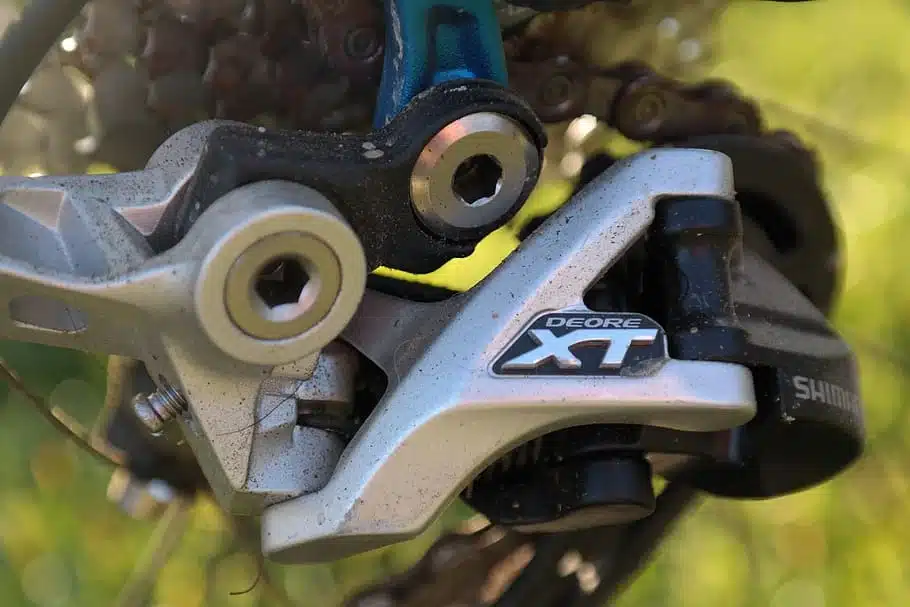Alright, let’s talk bicycle derailleurs. And before you ask – yes, this matters more than you think.
Look, I get it. When you’re building or upgrading your bike, the bicycle derailleur might not be the most exciting component to research. It’s not as flashy as a new wheelset or as immediately noticeable as a carbon frame.
But here’s the thing – your derailleur is literally what makes or breaks every single shift you make on every single ride. Miss a shift on a steep climb? That’s on your derailleur. Smooth, seamless gear changes that feel like butter? Also your derailleur.
Today we’re putting two heavy hitters head-to-head: the SHIMANO XT RD-M8100-GS and the SRAM Force 10-speed. These aren’t just random picks – they represent two completely different philosophies in drivetrain design, and the choice between them says a lot about what kind of rider you are.
The Contenders
SHIMANO XT RD-M8100-GS: The 12-speed mountain bike workhorse that’s built for the modern 1x drivetrain world.
SRAM Force 10-speed: The road racing veteran that’s all about precision and weight savings.
Right off the bat, we’re looking at two very different animals here. The SHIMANO is newer tech, more speeds, designed for off-road punishment. The SRAM is older school, fewer gears, but with that laser-focused road racing DNA.
Build Quality: Where Your Money Goes
Let’s start with what you can actually see and feel.
The SHIMANO XT comes in with that signature SHIMANO build philosophy – it feels substantial. At 1.0 pounds, it’s not the lightest thing on the market, but when you hold it, you immediately understand why.
The aluminum construction has this reassuring heft, and the anodized finish isn’t just for looks – it’s actually protecting your investment. SHIMANO’s Shadow RD+ technology keeps everything tucked in close to the bike, which means less chance of trail damage and reduced chain slap.
The SRAM Force, on the other hand, is playing a completely different game. At 0.000625 pounds (that’s got to be a spec error, but let’s roll with the lightweight theme), this thing is built for speed.
We’re talking carbon fiber outer cage, magnesium inner parallelogram link – this is competition-grade materials all the way. It’s the kind of component where every gram was questioned and every design choice was made with aerodynamics and weight in mind.
The Tech That Actually Matters
Here’s where things get interesting, and where your riding style really determines the winner.
SHIMANO’s HYPERGLIDE+ technology isn’t just marketing speak – it’s the reason you can shift under load without that jarring clunk. When you’re grinding up a technical climb and need to drop a gear mid-pedal stroke, this tech makes it happen seamlessly.
The 13-tooth pulleys with sealed bearings mean smoother operation and longer service intervals. Plus, that 51-tooth capacity means you can run massive cassettes for those ultra-low climbing gears.
SRAM’s Exact Actuation is all about precision. That 3mm shift travel isn’t arbitrary – it’s tuned for the most positive, definitive shift feel possible. When you click that shifter, you know exactly what gear you’re in. No guessing, no half-shifts, no wondering if it engaged properly.
The carbon fiber construction isn’t just about weight – it’s stiffer, which translates to more precise shifting under power. This is the kind of bicycle derailleur engineering that separates good components from great ones.
Real-World Performance
Let’s cut through the marketing and talk about what these actually feel like to ride.
SHIMANO XT: This is the derailleur for riders who want their bike to just work, every time, in every condition. Whether you’re covered in mud, dealing with a bent hanger, or just haven’t cleaned your bike in longer than you’d care to admit, this thing keeps shifting.
The 12-speed range gives you options – you’ve got climbing gears that’ll get you up anything, and still enough top-end for those fire road descents. It’s not the fastest shifting system out there, but it’s probably the most reliable.
SRAM Force: This is surgical precision in derailleur form. Every shift is crisp, immediate, and exactly where you expect it to be.
On a well-maintained road bike with a clean drivetrain, this thing is poetry in motion. But – and this is important – it demands respect. Keep it clean, keep it adjusted, and it’ll reward you with shifting that feels telepathic. Neglect it, and you’ll know immediately.
The Compatibility Question
This is where things get practical really quickly.
The SHIMANO is built for modern mountain bike drivetrains. 1×12 setups, massive cassettes, wide-range gearing – this is its natural habitat. If you’re running or planning to run a modern mountain bike drivetrain, this is plug-and-play compatibility.
The SRAM Force is old-school road in the best way possible. 10-speed systems, traditional cassette sizes (maxing out at 28 teeth), and designed for front derailleur compatibility. If you’re running a classic road setup or prefer the more evenly-spaced gearing of a 10-speed system, this is your derailleur.
Price and Value
Let’s be honest about what you’re actually paying for.
The SHIMANO XT represents solid value in the modern mountain bike world. You’re getting current technology, wide compatibility, and SHIMANO’s legendary reliability. It’s not cheap, but for what you get – especially if you’re running a 1×12 setup – it’s hard to argue with the value proposition.
The SRAM Force is more of a specialist purchase. You’re paying for premium materials, surgical precision, and that unmistakable SRAM shift feel. It’s not exactly budget-friendly, but for riders who prioritize shifting performance above all else, it’s worth every penny.
The Best Bicycle Derailleur for Your Riding Style
Here’s the reality: both of these derailleurs are excellent at what they’re designed to do. The question isn’t which one is better – it’s which one is better for you.
Choose the SHIMANO XT if: You want modern mountain bike capability, maximum reliability, and the ability to run huge cassettes for climbing. This is the derailleur for riders who want their bike to work perfectly regardless of conditions.
Choose the SRAM Force if: You prioritize shifting precision above all else, you’re running a traditional road setup, and you don’t mind the extra maintenance that comes with high-performance components.
The truth is, in 2025, both companies have figured out how to make derailleurs that shift better than most of us can even appreciate. Your choice comes down to riding style, bike setup, and personal preference.
But if I’m being completely honest? For most riders, the SHIMANO XT is probably the smarter choice. It’s more forgiving, more versatile, and more future-proof. The SRAM Force is beautiful, precise, and incredibly satisfying to use – but it asks more of you as a rider and mechanic.
Either way, you’re upgrading your shifting game significantly. Just make sure you pick the bicycle derailleur that matches how you actually ride, not how you think you should ride.
Now get out there and test some gears.









